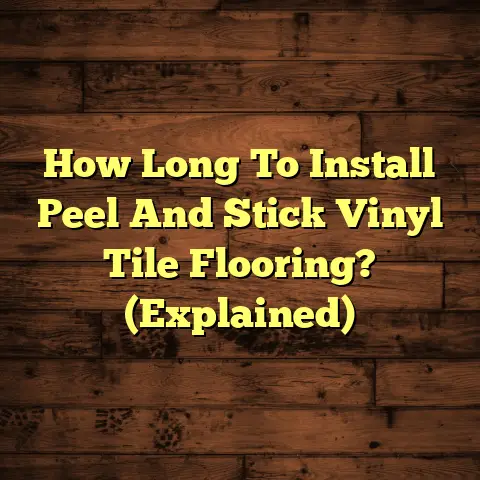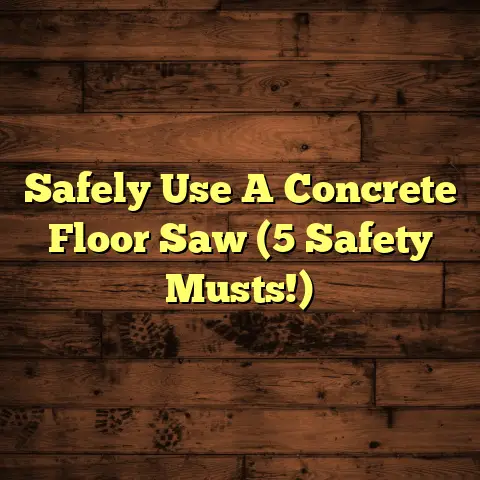Hardwood Over Crawl Space? (3 Subfloor Secrets!)
Let’s talk floors.
I mean, seriously, think about it:
Your flooring is the first thing people notice when they walk into your home.
It sets the stage, doesn’t it?
It’s not just about looks, though.
It’s about comfort, how the space feels, and how well it functions for your family.
And when it comes to timeless elegance and durability, hardwood is still king (or queen!).
But, and this is a big but, installing hardwood over a crawl space?
That’s a whole different ball game.
Trust me, I’ve seen it all in my years as a flooring contractor.
There are hidden challenges, often overlooked, that can make or break your beautiful hardwood dreams.
That’s why I’m here to spill the beans – the subfloor secrets, if you will – to help you avoid costly mistakes and achieve flooring perfection.
Section 1: Understanding Crawl Spaces
Okay, let’s start with the basics.
Define Crawl Spaces
What is a crawl space, anyway?
Well, it’s that unfinished, often cramped area beneath your house.
Think of it as a mini-basement, usually ranging from 1 to 3 feet in height.
Its main purpose?
To provide access to plumbing, electrical, and HVAC systems.
Most crawl spaces are constructed from concrete blocks or poured concrete foundations.
Sometimes, you’ll even see wood framing used, especially in older homes.
The Role of Subfloors
Now, let’s talk subfloors.
This is the unsung hero that supports your gorgeous hardwood.
Think of it as the foundation for your finished floor.
Typically, subfloors are made from plywood or OSB (oriented strand board).
These materials are strong and stable enough to provide a solid base for the hardwood installation.
But here’s the catch:
These materials are also susceptible to moisture damage, especially in a crawl space environment.
Environmental Factors
And that brings us to the elephant in the room: the crawl space environment.
Humidity, temperature fluctuations, and ventilation (or lack thereof) can wreak havoc on your hardwood floor.
Crawl spaces tend to be damp places, and that moisture can easily seep into the subfloor and, ultimately, into your hardwood.
According to the EPA, high humidity levels
can promote mold growth and attract pests,
further compromising the structural integrity
of your flooring system.
EPA Mold Resources
Section 2: Secret #1 – Moisture Control
Alright, let’s dive into the first, and arguably most crucial, secret: moisture control.
Understanding Moisture Issues
Moisture is the enemy of hardwood, plain and simple.
Too much moisture can cause cupping, crowning, warping, and even mold growth.
And guess where moisture loves to hang out?
Yep, crawl spaces.
I’ve seen countless hardwood floors ruined by moisture damage stemming from poorly managed crawl spaces.
It’s a heartbreaking sight, let me tell you.
According to a study by the Advanced Energy “crawl spaces with proper moisture management systems have significantly lower humidity levels and reduced risk of mold growth”.
Signs of Moisture Problems
How do you know if you have a moisture problem in your crawl space?
Here are a few telltale signs I always look for:
-
Musty odors: That’s a classic sign of mold and mildew.
-
Visible mold or mildew: Look for dark spots or fuzzy growth on the subfloor, walls, or insulation.
-
Warped or buckled flooring: This indicates that the wood has absorbed too much moisture and is expanding.
-
Condensation on pipes or walls: This is a sign of high humidity levels.
-
Insect infestations: Pests like termites and carpenter ants thrive in damp environments.
I remember one time, I was called to inspect a home with severely buckled hardwood floors.
The homeowner swore they had no leaks or water damage.
But when I crawled into the crawl space, it was like stepping into a swamp!
There was standing water, mold everywhere, and the subfloor was completely rotted.
The culprit?
A poorly installed vapor barrier and inadequate drainage.
Solutions for Moisture Management
So, how do you combat moisture in a crawl space?
Here are a few effective methods:
Vapor Barriers: This is your first line of defense.
A vapor barrier is a plastic sheet that covers the ground in the crawl space, preventing moisture from evaporating into the air.
Make sure it’s at least 6-mil thick and properly sealed at the seams and edges.Proper Drainage: Ensure that rainwater is diverted away from the foundation of your home with properly functioning gutters and downspouts.
Consider installing a French drain around the perimeter of the foundation to further improve drainage.Humidity Control Systems: In some cases, you may need to install a dehumidifier to actively remove moisture from the air.
Look for a model specifically designed for crawl spaces and make sure it’s properly sized for the space.Crawl Space Encapsulation: This is a more comprehensive solution that involves sealing the crawl space with a heavy-duty vapor barrier and insulating the walls.
This creates a controlled environment that is less susceptible to moisture problems.
Regular inspections are also crucial.
I always recommend homeowners inspect their crawl spaces at least twice a year, especially after heavy rains or during periods of high humidity.
Catching moisture problems early can save you a lot of headaches (and money!) down the road.
Section 3: Secret #2 – Insulation and Energy Efficiency
Now, let’s move on to the second secret: insulation and energy efficiency.
The Importance of Insulation
Insulation plays a vital role in maintaining a consistent temperature in your home.
In a crawl space, insulation helps to prevent heat loss in the winter and keep the space cooler in the summer.
Without proper insulation, you’re essentially throwing money out the window (or, in this case, the crawl space vent!).
Poor insulation can lead to higher energy bills and uncomfortable temperature fluctuations throughout your home.
Types of Insulation
There are several types of insulation that can be used in crawl spaces:
Fiberglass: This is a common and relatively inexpensive option.
However, fiberglass can lose its effectiveness if it gets wet, so it’s important to ensure that it’s properly protected from moisture.Foam Board: This is a rigid insulation material that is resistant to moisture and provides good insulation value.
It’s often used to insulate crawl space walls.Spray Foam: This is a more expensive option, but it provides excellent insulation and also helps to seal air leaks.
It’s a good choice for crawl spaces with irregular shapes or hard-to-reach areas.
Impact on Hardwood Flooring
So, how does insulation affect your hardwood floor?
Well, proper insulation helps to maintain a consistent temperature and humidity level in the crawl space, which in turn helps to prevent expansion and contraction of the hardwood.
When hardwood expands and contracts too much, it can lead to cracking, buckling, and other problems.
By keeping the environment stable, insulation helps to prolong the life of your hardwood floor and keep it looking beautiful for years to come.
I had a client who complained that their hardwood floors were constantly creaking and shifting.
After inspecting their crawl space, I discovered that it was completely uninsulated.
The temperature fluctuations in the crawl space were causing the hardwood to expand and contract excessively, leading to the creaking and shifting.
Once we insulated the crawl space, the problem disappeared.
Section 4: Secret #3 – Ventilation and Air Quality
And now, for the third and final secret: ventilation and air quality.
The Role of Ventilation
Ventilation is essential for preventing moisture buildup and improving air quality in crawl spaces.
Without proper ventilation, stagnant air can lead to mold growth, musty odors, and other air quality issues.
These issues can not only damage your hardwood floor but also affect the health of your family.
According to the American Lung Association,
poor indoor air quality can contribute to
respiratory problems, allergies, and other health
issues.
American Lung Association
Methods of Ventilation
There are several methods of ventilation that can be used in crawl spaces:
Passive Vents: These are simple openings in the foundation walls that allow air to circulate naturally.
However, passive vents may not be sufficient in areas with high humidity.Exhaust Fans: These fans actively remove stale air from the crawl space and replace it with fresh air.
They can be controlled by a humidistat to automatically turn on when humidity levels rise.-
Dehumidifiers: As mentioned earlier, dehumidifiers can help to remove moisture from the air and improve air quality.
I remember one homeowner who had a terrible mold problem in their crawl space.
They had passive vents, but they were completely blocked by overgrown bushes.
As a result, there was no air circulation in the crawl space, and moisture was trapped inside.
Once we cleared the bushes and installed an exhaust fan, the mold problem quickly resolved.
Connection to Flooring Health
Adequate ventilation is crucial for prolonging the lifespan of your hardwood floor.
By preventing moisture-related problems and maintaining a stable environment, ventilation helps to keep your hardwood looking its best for years to come.
Think of it this way:
Your crawl space is like the lungs of your home.
If it’s not breathing properly, it’s going to affect the health of everything else, including your hardwood floor.
Section 5: Installation Tips for Hardwood Over Crawl Space
Okay, so you’ve addressed the moisture, insulation, and ventilation issues in your crawl space.
Now, let’s talk about the actual installation of your hardwood floor.
Choosing the Right Hardwood
Not all hardwood is created equal.
When installing hardwood over a crawl space, it’s important to choose a species that is relatively moisture-resistant.
Some good options include:
-
Oak: A classic choice that is known for its durability and moisture resistance.
-
Maple: A hard and dense wood that is less prone to warping than some other species.
-
Hickory: A very hard and durable wood that is also relatively moisture-resistant.
Acclimatization is also crucial.
Before installing your hardwood, allow it to acclimate to the environment in your home for several days.
This will allow the wood to adjust to the temperature and humidity levels, which will help to prevent warping and other problems.
Installation Techniques
There are several installation methods that are compatible with crawl spaces:
Nail Down: This is a traditional method that involves nailing the hardwood planks directly to the subfloor.
It’s a good choice for solid hardwood flooring.Glue Down: This method involves gluing the hardwood planks to the subfloor.
It’s a good choice for engineered hardwood flooring.Floating Installations: This method involves installing the hardwood planks over a thin foam underlayment.
The planks are not attached to the subfloor, but rather click together to form a floating floor.
This method is a good choice for both solid and engineered hardwood flooring.
Always follow the manufacturer’s guidelines when installing your hardwood floor.
Post-Installation Care
Once your hardwood floor is installed, it’s important to take proper care of it to ensure its longevity.
Here are a few tips:
-
Regular Cleaning: Sweep or vacuum your hardwood floor regularly to remove dirt and debris.
-
Humidity Monitoring: Monitor the humidity levels in your home and adjust your humidifier or dehumidifier as needed to maintain a stable environment.
-
Seasonal Adjustments: During the winter months, when the air is drier, you may need to use a humidifier to prevent the hardwood from drying out and cracking.
Conclusion
So, there you have it:
The three subfloor secrets to installing hardwood over a crawl space.
It’s not always easy, but with the right knowledge and preparation, you can achieve stunning, durable flooring that enhances your home’s aesthetic while ensuring comfort and stability.
Remember, your crawl space is the foundation for your hardwood floor.
Take care of it, and it will take care of you.
Now, go forth and create the hardwood floor of your dreams!





